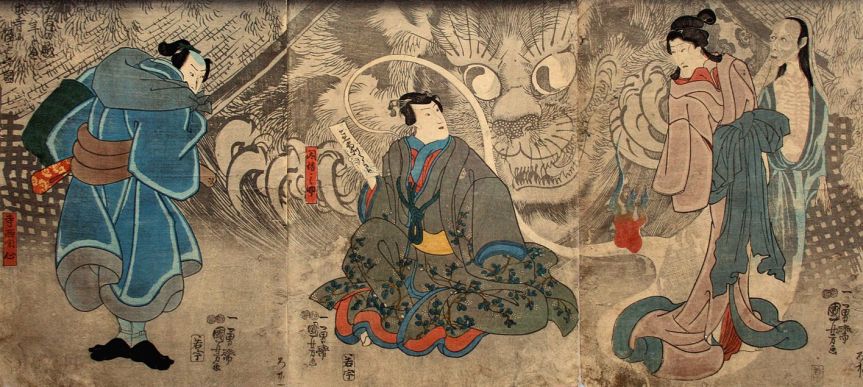Utagawa Kuniyoshi (1798 – 1861) was a Japanese painter in the late Edo period specialising in Ukiyo-e woodblock painting (he was a contemporary of Hokusai). Kuniyoshi was known for his very detailed, “full-of-action” woodblock paintings (triptychs), showing the scenes from the Japanese life, mythology (the supernatural, including monsters), as well as the actions of the samurai. Some of his paintings are very graphic and rather violent. Below are three paintings of Kuniyoshi that depict ghosts.

I. Takiyasha the Witch and the Skeleton Spectre
The background story to this macabre print has is that there was once the war-lord Taira no Masakado (living in the 10th century) who was killed after he started a rebellion against the court at Kyoto. The daughter of Taira, Princess Takiyasha (who was also a witch), was devastated that her father was killed and the rebellion proved unsuccessful. Thus, she (positioned to the left in this print) magically summoned the ghosts of the dead rebellious soldiers of her father by reading through the magical scroll. The ghosts she summoned then took the form of one giant skeleton (Gashadokuro). On the foreground of the print, one can see the remaining plotter, as well as the leading warrior Oya no Taro Mitsukuni, trying to subdue the ghostly rebellion once again.

II. Scene from a Ghost Story – The Okazaki Cat Demon
This woodblock print depicts a scene (Act 1 Scene 19) taken from the play Hitori Tabi Gojusan Tsugi (Travelling Alone to the Fifty-Three Stations) [1827] by Tsuruya Nanboku IV. The play is nicknamed “Okazaki no Neko” (“The Cat of Okazaki”) because the scene is inspired by an urban legend that a ghost of a cat haunts the houses along one road in Okazaki, Aichi Prefecture, Japan. The background story to this scene is that there were three travellers, all friends, returning from their pilgrimage and travelling in Okazaki, when they approached an old abandoned temple Muryoji. The travellers found an old poor woman Osan living there who invites them in to spend the night. The travellers then see the dance of two cats who perform acrobatic movements on their hind legs, but the owner assures the guests that it is a normal occurrence. Upon being alone with Osan in a room, one of the travellers then comes close to a lantern filled with fish oil and sees Osan’s shadow on the wall taking the form of a giant cat-spirit. This female traveller then screams and does not return from her room. Another female traveller meets a similar end, being clawed to death by the giant cat. The remaining male traveller then sees Osan and realises that she is, in fact, a giant cat-spirit who has just murdered his two friends. The battle ensues between him and Osan, and the man’s sword finally overpowers the cat. The cat-spirit transpired to be a malevolent spirit that took the body of Osan to avenge his clan.

III. The Ghosts of the Taira Attack Yoshitsune in Daimotsu Bay
In this thought-provoking print inspired by the Kabuki play Benkei on the Boat, General Minamoto no Yoshitsune (1159-1189) and his fleet find themselves battling the storm in Daimotsu Bay. However, another great wave brings about the ghosts of the General’s defeated enemies who try to surround the ship. His defeated enemies are from the clan Taira, that historically waged the war against Minamoto. The legend has it that one of the Minamoto’s lieutenants managed to drive away the ghosts by starting a prayer.
Other intriguing, even if more graphic, “ghost” paintings by Kuniyoshi are The Ghosts of Togo and His Wife, and Oiwake from The Sixty-Nine Post Stations of the Kisokaido Road series.


Fascinating, the first one in particular!
LikeLiked by 1 person
Thanks for reading! 🙂
LikeLiked by 1 person
Wow! Very informative.
LikeLiked by 1 person
Unusually! Very interesting!
LikeLiked by 1 person
yikes — Japanese ghost stories are the scariest.
LikeLiked by 1 person
This is stunning and beautiful. Thank you so much for sharing it with us. Love the witch and the skeleton one.
LikeLiked by 1 person